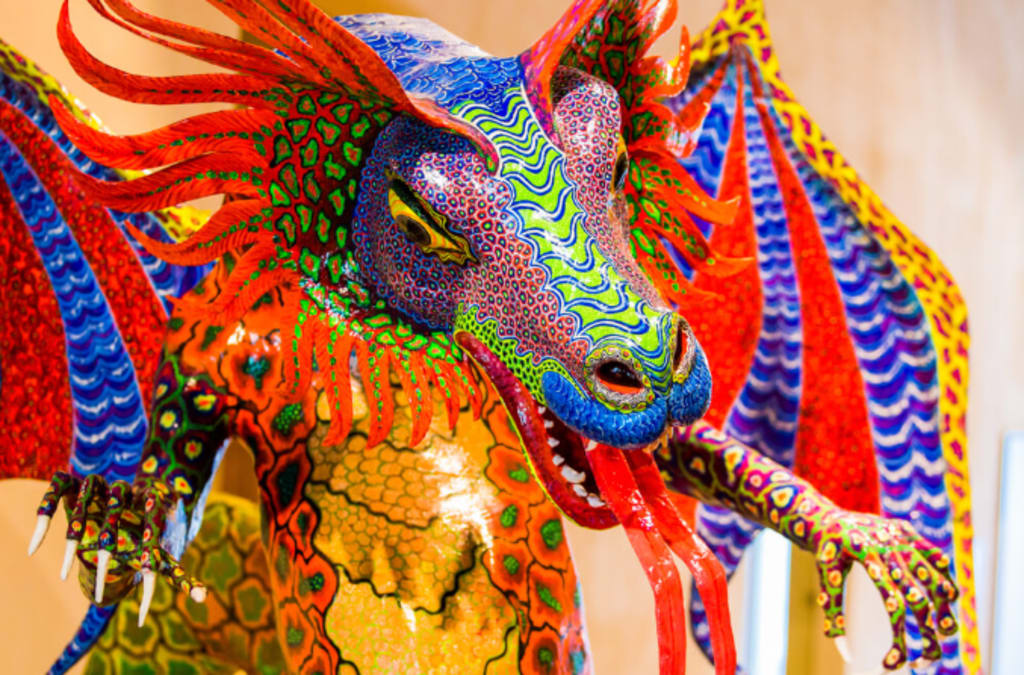
Nestled in the southern region of Mexico lies the vibrant state of Oaxaca, renowned for its rich cultural heritage and centuries-old tradition of folk art. From intricately crafted textiles and pottery to exquisitely carved wooden figures, Oaxacan folk art is a testament to the creativity and ingenuity of its indigenous artisans. This article delves into the captivating history of Oaxacan folk art, tracing its evolution from ancient indigenous practices to its flourishing presence in the contemporary art world.
The history of Oaxacan folk art can be traced back to pre-Columbian times when the region was inhabited by various indigenous civilizations, including the Zapotec, Mixtec, and Mixe peoples. These ancient cultures had a profound appreciation for craftsmanship and artistic expression, evident in the intricate pottery, textiles, and ceremonial objects they produced.
One of the most iconic examples of Oaxacan folk art is the tradition of pottery-making, which dates back thousands of years. Artisans in Oaxaca utilize traditional techniques passed down through generations to create stunning clay vessels adorned with intricate designs inspired by nature, mythology, and indigenous symbols.
The arrival of Spanish conquistadors in the 16th century brought significant changes to the artistic landscape of Oaxaca. European influences, combined with indigenous traditions, gave rise to a unique style of folk art characterized by vibrant colors, intricate patterns, and religious symbolism.
During the colonial period, Oaxacan artisans began to incorporate Christian motifs into their artwork, blending indigenous beliefs with Catholicism to create a distinctive visual language. This syncretism is evident in the elaborately decorated retablos (religious paintings), carved wooden saints, and intricately woven textiles that continue to be produced in Oaxaca to this day.
In the late 19th and early 20th centuries, Oaxacan folk art experienced a revival as artists and collectors sought to preserve and celebrate the region's cultural heritage. Influential figures such as Mexican painter and ethnographer Francisco Toledo played a pivotal role in promoting Oaxacan folk art and supporting local artisans.
Toledo's efforts helped to revitalize traditional art forms such as weaving, pottery, and woodcarving, sparking a renewed interest in Oaxacan folk art both within Mexico and abroad. His advocacy for indigenous rights and cultural preservation continues to inspire contemporary artists and activists in Oaxaca.
Today, Oaxacan folk art remains a vital and dynamic aspect of the region's cultural identity, with artisans continuing to innovate and adapt traditional techniques to suit modern tastes and market demands. The work of contemporary artists such as Jacobo and María Ángeles, renowned for their intricately carved wooden alebrijes (fantastical creatures), exemplifies the ongoing evolution of Oaxacan folk art.
Jacobo and María Ángeles are internationally recognized for their imaginative designs and masterful craftsmanship, which have earned them numerous awards and accolades. Their alebrijes, often inspired by animals and mythological creatures, are characterized by intricate detailing, vibrant colors, and a whimsical sense of imagination.
In addition to the Ángeles family, other notable artists contributing to the contemporary Oaxacan folk art scene include ceramicist Dolores Porras, whose handcrafted pottery reflects the traditions of her Zapotec heritage, and textile artist Erasto Mendoza, known for his intricately woven rugs and tapestries inspired by ancient motifs and symbols.
Despite the challenges posed by globalization and modernization, Oaxacan folk art continues to thrive as a vibrant expression of the region's cultural heritage. Organizations such as the Instituto de Artes Gráficas de Oaxaca (IAGO) and the Museo de Arte Popular de Oaxaca (MAPO) are dedicated to preserving and promoting traditional art forms through exhibitions, workshops, and educational programs.
Through their efforts, Oaxacan folk art remains a source of pride and inspiration for the people of Oaxaca, serving as a reminder of the enduring legacy of creativity, craftsmanship, and cultural resilience that defines this remarkable region. As the world evolves and changes, Oaxacan folk art stands as a timeless testament to the power of tradition and the enduring beauty of indigenous culture.
About the Creator
Janie
Passionate about unraveling the intricate tapestry of art history and contemporary artistic expressions. Beyond brushstrokes and colors, into the mental and physical struggles of artists.






Comments
Janie is not accepting comments at the moment
Want to show your support? Send them a one-off tip.